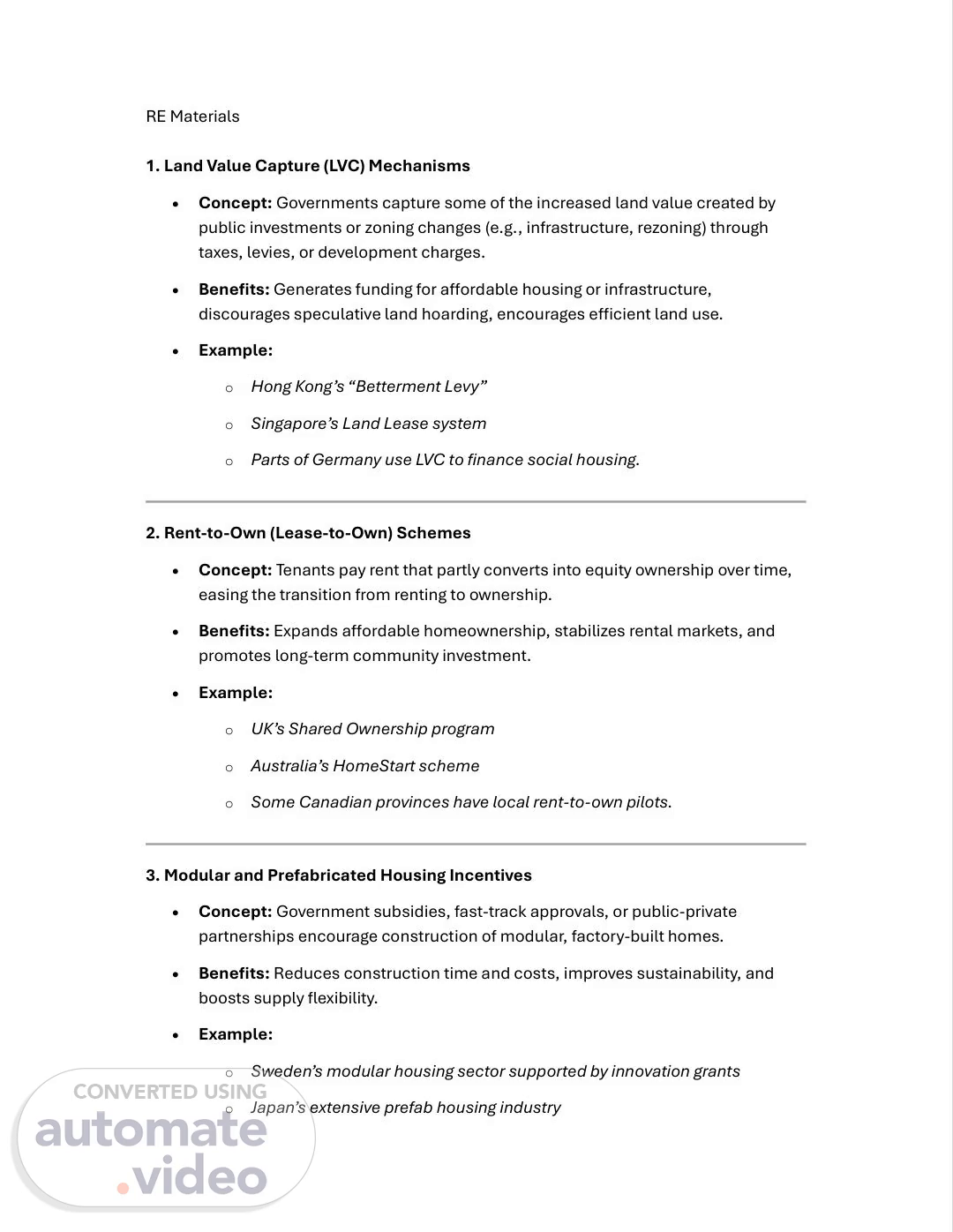Scene 1 (0s)
[Audio] RE Materials 1. Land Value Capture (L-V-C--) Mechanisms Concept: Governments capture some of the increased land value created by public investments or zoning changes (for example, infrastructure, rezoning) through taxes, levies, or development charges. Benefits: Generates funding for a�ordable housing or infrastructure, discourages speculative land hoarding, encourages e�icient land use. Example: o Hong Kong’s “Betterment Levy” o Singapore’s Land Lease system o Parts of Germany use L-V-C to finance social housing. 2. Rent to Own (Lease to Own) Schemes Concept: Tenants pay rent that partly converts into equity ownership over time, easing the transition from renting to ownership. Benefits: Expands a�ordable homeownership, stabilizes rental markets, and promotes long term community investment. Example: o UK’s Shared Ownership program o Australia’s HomeStart scheme o Some Canadian provinces have local rent to own pilots. 3. Modular and Prefabricated Housing Incentives Concept: Government subsidies, fast track approvals, or public private partnerships encourage construction of modular, factory built homes. Benefits: Reduces construction time and costs, improves sustainability, and boosts supply flexibility. Example: o Sweden’s modular housing sector supported by innovation grants o Japan’s extensive prefab housing industry.
Scene 2 (1m 34s)
[Audio] o Netherlands pilot projects for rapid modular construction. 4. Public Private Partnership (P-P-P--) A�ordable Housing Funds Concept: Collaborative funds where government, private investors, and developers pool resources to build or subsidize a�ordable housing. Benefits: Leverages private capital with public oversight, shares risk, aligns incentives. Example: o France’s “Société d’économie mixte” (S-E-M--) housing vehicles o UK’s Housing Associations partnering with private investors o U-S Low Income Housing Tax Credit (L-I-H-T-C) programs. 5. Vacant Property Taxes and Speculation Surcharges Concept: Taxing or penalizing properties left vacant or held speculatively to encourage market liquidity. Benefits: Frees up housing stock, reduces speculative price inflation. Example: o Vancouver’s Empty Homes Tax o Paris’ tax on vacant dwellings o Madrid’s vacancy surcharges. 6. Inclusionary Zoning / Mandatory A�ordable Quotas Concept: Developers must allocate a percentage of new housing units as a�ordable for moderate income households. Benefits: Directly increases a�ordable housing supply. Example: o New York City’s Inclusionary Housing Program o London’s A�ordable Housing requirements o Parts of Germany’s social housing mandates..
Scene 3 (2m 45s)
[Audio] 7. Secondary Market Interventions Concept: Government or institutional players actively purchase and manage housing stock to stabilize prices or provide rental housing. Benefits: Controls market bubbles, increases a�ordable rental stock. Example: o Singapore’s Housing Development Board (H-D-B--) interventions o Sweden’s municipal housing companies o Luxembourg’s S-N-C-I could expand into this role..
